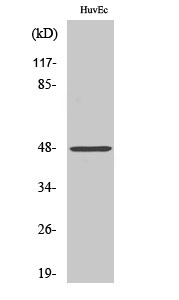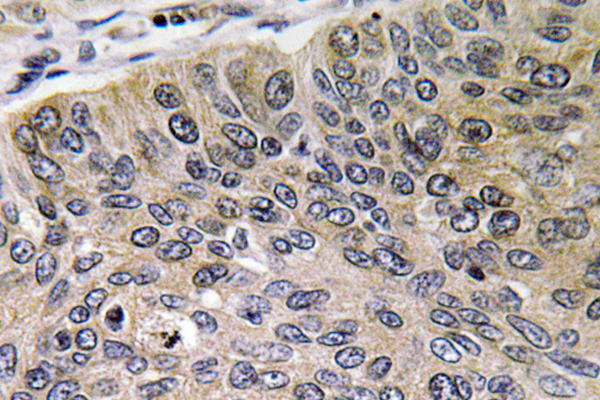Cathepsin E Polyclonal Antibody
- Catalog No.:YT0682
- Applications:WB;IHC;IF;ELISA
- Reactivity:Human;Mouse;Rat
- Target:
- Cathepsin E
- Fields:
- >>Lysosome
- Gene Name:
- CTSE
- Protein Name:
- Cathepsin E
- Human Gene Id:
- 1510
- Human Swiss Prot No:
- P14091
- Mouse Gene Id:
- 13034
- Mouse Swiss Prot No:
- P70269
- Rat Gene Id:
- 25424
- Rat Swiss Prot No:
- P16228
- Immunogen:
- The antiserum was produced against synthesized peptide derived from human Cathepsin E. AA range:243-292
- Specificity:
- Cathepsin E Polyclonal Antibody detects endogenous levels of Cathepsin E protein.
- Formulation:
- Liquid in PBS containing 50% glycerol, 0.5% BSA and 0.02% sodium azide.
- Source:
- Polyclonal, Rabbit,IgG
- Dilution:
- WB 1:500 - 1:2000. IHC 1:100 - 1:300. ELISA: 1:20000.. IF 1:50-200
- Purification:
- The antibody was affinity-purified from rabbit antiserum by affinity-chromatography using epitope-specific immunogen.
- Concentration:
- 1 mg/ml
- Storage Stability:
- -15°C to -25°C/1 year(Do not lower than -25°C)
- Other Name:
- CTSE;Cathepsin E
- Observed Band(KD):
- 48kD
- Background:
- This gene encodes a member of the A1 family of peptidases. Alternative splicing of this gene results in multiple transcript variants. At least one of these variants encodes a preproprotein that is proteolytically processed to generate the mature enzyme. This enzyme, an aspartic endopeptidase, may be involved in antigen processing and the maturation of secretory proteins. Elevated expression of this gene has been observed in neurodegeneration. [provided by RefSeq, Nov 2015],
- Function:
- catalytic activity:Similar to cathepsin D, but slightly broader specificity.,function:May have a role in immune function. Probably involved in the processing of antigenic peptides during MHC class II-mediated antigen presentation. May play a role in activation-induced lymphocyte depletion in the thymus, and in neuronal degeneration and glial cell activation in the brain.,PTM:Glycosylated. The nature of the carbohydrate chain varies between cell types. In fibroblasts, the proenzyme contains a high mannose-type oligosaccharide, while the mature enzyme contains a complex-type oligosaccharide. In erythrocyte membranes, both the proenzyme and mature enzyme contain a complex-type oligosaccharide.,PTM:Two forms are produced by autocatalytic cleavage, form I begins at Ile-54, form II begins at Thr-57.,similarity:Belongs to the peptidase A1 family.,subcellular location:The proenzyme is localized
- Subcellular Location:
- Endosome . The proenzyme is localized to the endoplasmic reticulum and Golgi apparatus, while the mature enzyme is localized to the endosome.
- Expression:
- Expressed abundantly in the stomach, the Clara cells of the lung and activated B-lymphocytes, and at lower levels in lymph nodes, skin and spleen. Not expressed in resting B-lymphocytes.
- June 19-2018
- WESTERN IMMUNOBLOTTING PROTOCOL
- June 19-2018
- IMMUNOHISTOCHEMISTRY-PARAFFIN PROTOCOL
- June 19-2018
- IMMUNOFLUORESCENCE PROTOCOL
- September 08-2020
- FLOW-CYTOMEYRT-PROTOCOL
- May 20-2022
- Cell-Based ELISA│解您多样本WB检测之困扰
- July 13-2018
- CELL-BASED-ELISA-PROTOCOL-FOR-ACETYL-PROTEIN
- July 13-2018
- CELL-BASED-ELISA-PROTOCOL-FOR-PHOSPHO-PROTEIN
- July 13-2018
- Antibody-FAQs
- Products Images

- Western Blot analysis of various cells using Cathepsin E Polyclonal Antibody

- Immunohistochemistry analysis of Cathepsin?E antibody in paraffin-embedded human lung carcinoma tissue.

- Western blot analysis of lysate from HUVEC cells, using Cathepsin?E antibody.



